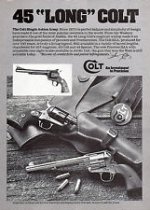The whole S&W discussion of whether to call them stocks, checking and yoke OR grips, checkering and crane comes from early S&W literature. Since the founders, Horace and Daniel, chose to use the terms stocks, checking and yoke, then to be true to the men that formed the company I use their terms.
While it is true that many folks in the gun world including the current ownership and the company historian have decided not to fight current trends and use mainstream terms, it does not change the fact that the founders of the company chose those words.
I do not know their reasoning. It is possible that they purposely used these words to be different from their largest competitor, COLT. I know that they did not like using the word COLT on their firearms when the gun fired a cartridge containing the word COLT.
So call it what you wish, but the men that formed the company did it for a reason and I will honor their decision as a collector and shooter of their guns. It's a free country (except for taxes) so do what you wish.




